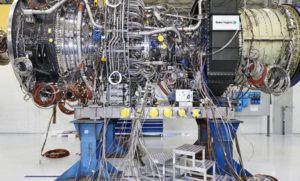LM9000 tested amidst Covid; claims to match LMS100 efficiency

LM9000[/caption]
Baker Hughes said it has completed the First Engine to Test (FETT) for the LM9000 aeroderivative gas turbine. The test took place at the company’s testing facilities in Florence and Massa, Italy.
In December 2018, NOVATEK selected Baker Hughes for the supply of LM9000 aeroderivative gas turbines for the Arctic LNG 2 Project. The successful FETT completion paves the way for the supply of the same turbines for NOVATEK's new LNG projects.
The LM9000 delivering 73 MW 50/60 Hz is claimed to have simple cycle efficiency in excess of 44% and a power output 15% higher compared to industry peers. The LMS100 with intercoolers specially designed to boost efficiency at power output in excess of 110 MW is claimed to clock similar efficiency levels at ISO. NOx is 15 ppm in dry condition.
The successful FETT leveraged Baker Hughes' turbomachinery remote testing capabilities to overcome travel restrictions imposed by COVID-19. More than 80 experts from various locations were connected remotely to perform the Full Speed and Full Load test. In addition, remote witness technology, such as smart glasses and helmets, enabled real-time and seamless sharing of machine inspections and virtual testing performed in Massa with the extended teams around the world.
Baker Hughes’ overall scope of work for Arctic LNG 2 includes the supply of turbomachinery equipment for power generation and three liquefaction trains on gravity-based structures (GBS) that will produce 6.6 million tons of LNG per annum each, for a total production of 19.8 MTPA.
The LM9000 boasts of a 50% increase of meantime between maintenance intervals versus current aeroderivative technology. With the ability to start in a fully pressurized condition, and 24-hour engine swap capability, the LM9000 can also reach over 99% availability.
Co-developed by Baker Hughes and GE, the LM9000 features a new driver specifically designed for the needs of LNG production. The design utilizes free-power turbine architecture that provides higher efficiency and enables the unit to operate over a wide range of speed settings from 2600 rpm to 3780 rpm with virtually unaffected power and efficiency. The free-power turbine also allows 50 Hz and 60 Hz power generation without needing a gearbox.
The BHGE LM9000 is based on BHGE Aviation’s GE90-115B Boeing 777 engine.
The LM9000 simplifies LNG plant design and associated CAPEX by eliminating the need for a helper motor, therefore allowing LNG train startup in the loaded (pressurized) condition without venting process gas. Its DLE technology enables dual fuel capability and reduces NOx emissions while eliminating water use in emissions abatement.
In addition to LNG applications both on and offshore, the LM9000 can provide simple cycle, cogeneration and combined cycle power generation.
Baker Hughes has invested in engineering and manufacturing tools, test beds and equipment for the LM9000 in its Florence and Massa facilities in Italy.